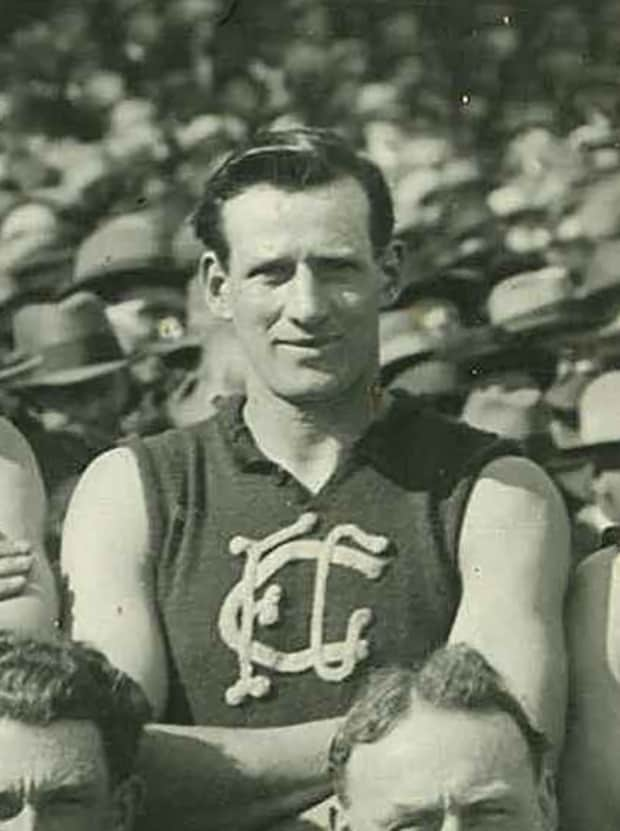Of the 28 Carlton footballers known to be of Italian origin, Albert Boromeo is numero uno. Ninety-seven years ago, in the opening round of the 1919 season against the now-defunct Fitzroy, Boromeo first ran out onto Princes Park.
On the eve of Sunday’s match, on a day in which Carlton President Mark LoGiudice acknowledges the contributions of the Club’s Italians, it is fitting that Boromeo’s story be told.
The son of an Italian-born father, and hailing from the tiny central Victorian goldfields town of Timor, Boromeo’s controversial senior debut (when the 26-year-old played in canvas boots having lobbied too late to be fitted for leathers) would be in keeping with the ruckman’s contentious last hurrah.
First impressions of Boromeo were glowing. "He gave decided promise, and looked every inch the footballer," according to Carlton’s famed former secretary/coach Jack Worrall, at that time covering the contest for The Argus newspaper.
Not surprisingly, Boromeo contributed to Carlton’s successes through the early 1920s, representing the team in finals in four of five seasons – initially as a follower, later as a foil for the club’s champion centre half-forward Horrie Clover. Clover, largely considered Carlton’s greatest footballer of the between-the-wars period, had been recruited to the club from Maryborough, just a few kilometres south of Boromeo’s home town.
Adjudged best on ground for the vanquished Blues in the 1921 Grand Final, Boromeo’s mastery of the craft saw him rewarded with regular state selection. He notched his 50th game for the Club against this Sunday’s opponent Melbourne in Round 4, 1922. But by the unlucky 13th round of 1923, against Essendon at Windy Hill and Boromeo’s 69th senior appearance in five seasons, it was all over for Timor’s own.
Carlton’s inauspicious 11-goal loss to the Same Olds in that contest prompted a calamitous series of events, which ended Boromeo’s time at Blueland, and that of teammate Dan Whannell, who six years later took his own life.
In the visitors’ rooms afterward, amid veiled references to players being got at, Carlton players George Bolt and Jack Morrissey engaged in a fist fight into which a trainer and a member of the club’s committee was drawn. Boromeo, meanwhile, was heard to level criticism his captain-coach Clover.
In the aftermath of the ugly affair, those involved were summonsed to appear before the match committee to explain their actions. Bolt and Morrissey were duly suspended, as was Boromeo, having stood accused of ‘creating dissension in the club’.
Secretary Reginald Hunt, in Carlton’s 59th Annual Report presented to Members at the Annual Meeting in February 1924, reflected on the previous year’s happenings.
Highlighting the fact that injury had cruelled the team’s chances through the first half of the ’23 season, with as many as eight regulars unavailable for selection, Hunt noted that “under this handicap, success could not be expected”.
“This, the committee was powerless to avoid, but later dissension crept into the team, and open hostility was shown to its elected leaders,” Hunt reported.
“To endeavor to smooth matters, the players were called together to talk over the situation, and although these efforts looked like succeeding, they, unfortunately, were a failure. The climax was reached in the Essendon match, on August 4th, and the drastic action of suspending three players had, after long deliberation, very reluctantly, to be taken.
“This incident was fully discussed at a special meeting of members called for the purpose. It might be mentioned that the Committee was unanimous in its decision, which was also endorsed by the whole of the players.”
In the wake of his suspension, Boromeo resigned as a Carlton player and promptly declared his interest in joining Richmond – a request initially denied him given that Richmond had proven a genuine nemesis. Not until 1926, when Carlton finally relented and released the 34 year-old to the Tigers, did the standoff end.
Boromeo turned out for Richmond in 14 games through the ’26 season. The following year he ‘went bush’, and played on into his forties, including at Horsham where he also officiated as publican of the town’s Victoria Hotel.
He died at the age of 78 in 1971.
In April 1923, just three months before his acrimonious parting of the ways with Carlton, Albert Boromeo articulated his thoughts on the art of ruck-play for The Herald. The following edited article, which appears on The Blueseum website, is reproduced as follows;
PLAYING IN THE RUCK
(Specially written for "The Melbourne Herald" by Bert Boromeo, the Champion Carlton Follower.)
I would rather Illustrate the art of ruck play on the field than try to explain it in an article, but here goes for a few instructions or hints on the best department of football.
Before coming to Melbourne I played centre forward, and in the ruck for Maryborough. I never enjoyed football so well as when I was following in the pack and meeting a doughty opponent. It is a delightful sensation to feel and know that you are playing well. That is always easy enough to tell, for you will handle the ball with every facility, and beat your opponent time and again for the mark.
Every follower will agree with me when I say that it is a horrible sensation when you are playing off color. It does not matter how good you are, a follower will always experience a bad day some time. Take, for an example, myself, against St Kilda last season. I followed the ball for most of the day, and could scarcely kick in the first half. Then, it is just as well to remember that you are always likely to strike a man a little better than yourself. You cannot always be in the limelight.
Play hard for your side, and do not worry over individual glory. The success of the individual is nothing compared with the success of the side. Occasionally there is a man in a team who will try and play the opposing side on his own. That player is under-estimating the ability of his comrades if he imagines that he is the only man who can achieve victory.
These are a few general points I would like young players to remember.
Practise assiduously.

Albert Boromeo pictured ahead of the 1922 semi-final at the MCG.
When training, I believe in smart work to reach a stage of physical perfection. At present I turn the scale at 14 stone, and am over six feet in height. By the time the first game starts I will probably be about 13 stone 10 lb. Great weight is not essential for a follower, and I have often observed how many good lighter men will hold their own simply because they are fine students of ruck play.
Different methods should be employed for the training of the various types of ruck men. If a player is at all fat and on the slow side, he must undergo a fairly exhaustive preparation before he can acquire stamina and pace. The lighter man does not want much heavy work. l used to do long runs at Carlton, but have given them up in preference to short, sharp sprints.
Ball practice is very essential. If you can handle the ball well, it is very rarely that you will fail in senior ranks. Skill and judgment are required for marking in the pack. A big, heavy man will never be a champion follower until he learns to spring off his feet for the ball.
Eat well and work.
I am not a faddist and like a good hard meal before any strenuous exercise. If a man eats as much as he wants and it is good food, he can have nothing to fear provided that when he trains he will buck into his work well. Do not worry over trivialities and take no notice of the barrackers. If they played better than you they would be on the field. Watch your captain for advice and play the game well and fairly, and no harm will come your way. A young ruck player never ceases learning, and always picks up a few wrinkles by playing against older men.


